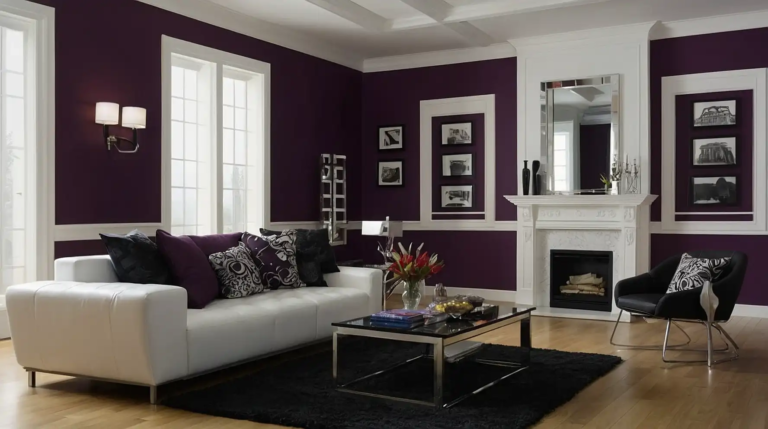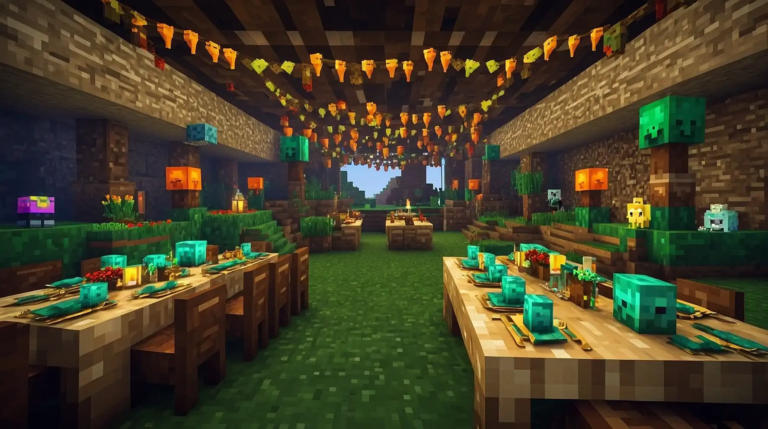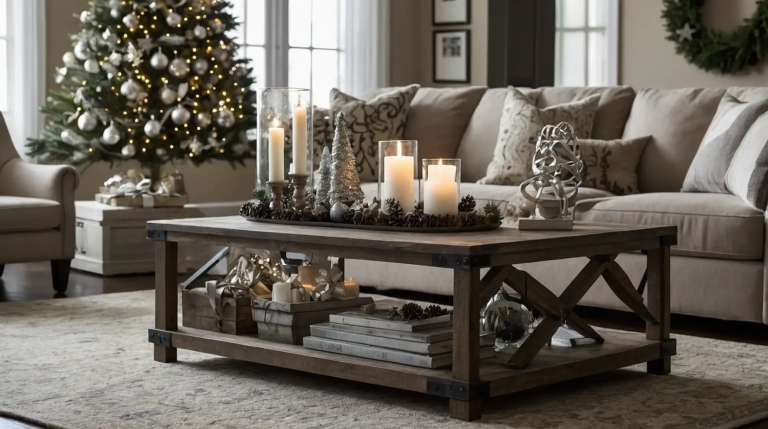27 Stunning Midcentury Modern Living Room Ideas to Transform Your Space
Midcentury modern design continues to captivate with its timeless blend of form and function.
This iconic style combines clean lines, organic shapes, and a connection to nature that feels both nostalgic and remarkably current.
Creating a midcentury modern living room doesn’t require a total overhaul. You can incorporate key elements while maintaining your personal style and existing pieces.
Whether you’re aiming for an authentic 1950s-60s look or a contemporary interpretation, these ideas will help you achieve that perfect balance of retro charm and modern livability.
1: Statement Chair Focus

Anchor your living room with an iconic midcentury chair like the Eames lounge, Egg chair, or Womb chair.
These sculptural pieces instantly communicate the design era’s aesthetic. Choose authentic vintage or high-quality reproductions depending on your budget.
Position your statement piece where it catches the eye immediately upon entering the room.
2: Low-Profile Sofa

Invest in a sofa with the hallmark midcentury characteristics: clean lines, tapered legs, and a low, horizontal profile.
Look for tufted details and armrests that angle slightly outward. Choose fabrics in period-appropriate colors like mustard, olive, or burnt orange for authenticity.
For a more subtle approach, opt for neutral upholstery and add color through accessories.
3: Functional Sputnik Chandelier
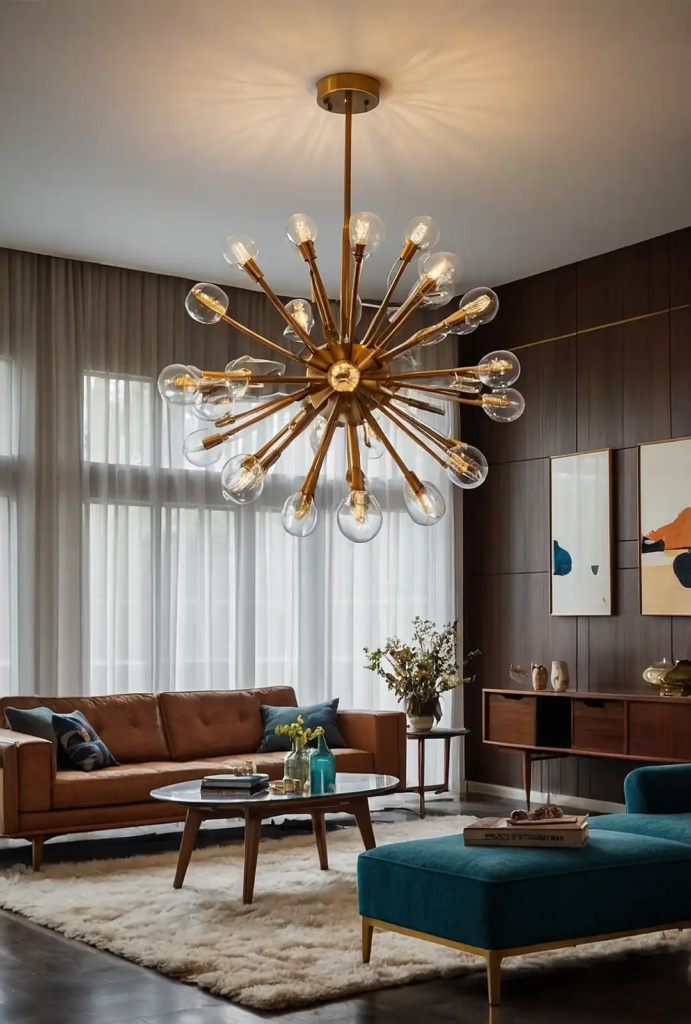
Install a Sputnik-style chandelier with radiating metal arms and globe bulbs.
This instantly recognizable lighting fixture adds drama while reflecting the space age influence on midcentury design.
Position it centrally over your seating area or coffee table to create a focal point. The starburst shape casts interesting shadows that add dimension to your ceiling after dark.
4: Walnut Wood Accents

Incorporate walnut furniture pieces with their distinctive rich, warm tone that defines midcentury modern spaces.
Look for simple, streamlined dressers, side tables, or credenzas. Choose pieces with minimal ornamentation that showcase the natural grain patterns.
This authentic material brings organic warmth to balance the clean lines of your space.
5: Geometric Area Rug

Ground your seating arrangement with a geometric or abstract patterned rug featuring bold shapes and period colors.
This textile addition ties the room together while adding visual interest. Look for designs with intersecting shapes, boomerangs, or starbursts.
A good rug defines your living space while introducing the playful patterns characteristic of midcentury style.
6: Teak Media Console

Replace your entertainment center with a low, horizontal teak credenza or media console.
These practical pieces offer storage while showcasing the beautiful wood grain central to midcentury aesthetic.
Look for sliding doors, tapered legs, and minimal hardware. Style the top with a record player, plants, or art objects rather than allowing technology to dominate.
7: Sunburst Clock Wall Art

Hang a sunburst clock or similar atomic-age wall decoration to create an authentic focal point. These distinctive timepieces merge functional timekeeping with sculptural wall art.
Choose brass, wood, or mixed materials for varied texture.
The radiating lines create visual energy and draw the eye upward, expanding your space visually.
8: Indoor Plants in Ceramic Planters

Incorporate substantial indoor plants like fiddle leaf figs, rubber plants, or palm varieties to bring the midcentury’s characteristic connection to nature indoors.
Place them in ceramic or wooden planters with patterns or textures typical of the era.
This greenery softens the room’s angular furniture while improving air quality and wellbeing.
9: Tulip Table Accent

Add a Saarinen-inspired tulip side table with its iconic pedestal base and smooth top. This space-age design eliminates visual clutter with its sleek silhouette.
Position between chairs or beside your sofa to hold drinks, books, or decorative objects.
The sculptural form functions as both practical surface and artistic statement.
10: Slim Floor Lamp

Illuminate your reading nook with an arching floor lamp featuring a slim profile and adjustable shade.
These functional art pieces provide directed light while adding vertical dimension.
Look for brass details and marble bases for authentic midcentury luxury. Position to arch over seating areas, creating architectural interest in otherwise empty vertical space.
11: Wall-Mounted Shelving System

Install a modular shelving system with adjustable components to display books, objects, and small plants.
These versatile units embodied the era’s focus on customizable, functional design.
Choose units with thin supports and varied compartment sizes. The open design maintains spaciousness while providing ample display and storage opportunities.
12: Abstract Art Focus

Feature large-scale abstract art with bold colors and geometric or organic forms.
Look for pieces featuring the spontaneous brushwork and color experimentation popular during the period. Create a gallery wall or choose one oversized piece as a focal point.
The artistic expression provides personality and color that complements the clean lines of your furniture.
13: Glass and Wood Coffee Table

Center your seating arrangement around a coffee table that combines wood and glass elements. The mixed materials exemplify midcentury design’s material innovation.
Look for organic shapes or hairpin legs for authentic character.
This transparent element creates visual spaciousness while providing necessary surface area for everyday use.
14: Room Divider Screening
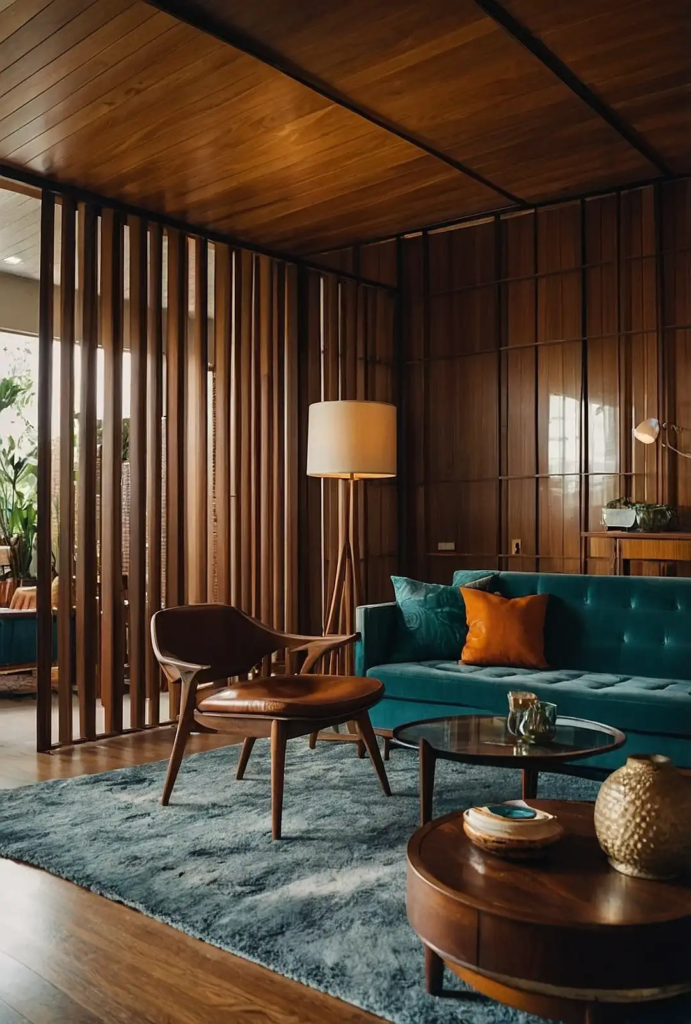
Define different areas within open floor plans using decorative screens or shelving units that serve as partial room dividers.
This approach maintains openness while creating distinct zones. Choose perforated wood panels, slatted designs, or open shelving.
These functional dividers add architectural interest while controlling sightlines through your space.
15: Conversation Pit Arrangement

Arrange your seating in a U-shape or complete circle to encourage face-to-face interaction, reminiscent of the era’s famous conversation pits.
This arrangement prioritizes human connection. Ensure all seats relate to a central coffee table.
This intentional layout facilitates the social interaction that midcentury homes were designed to encourage.
16: Vintage Bar Cart

Add a brass or wood bar cart stocked with period-appropriate glassware to channel the era’s cocktail culture.
This mobile entertainment station brings function and retro charm. Style with decanters, unique glasses, and cocktail tools.
This nostalgic element celebrates the sociability and hospitality central to midcentury home design.
17: Teak Slatted Bench
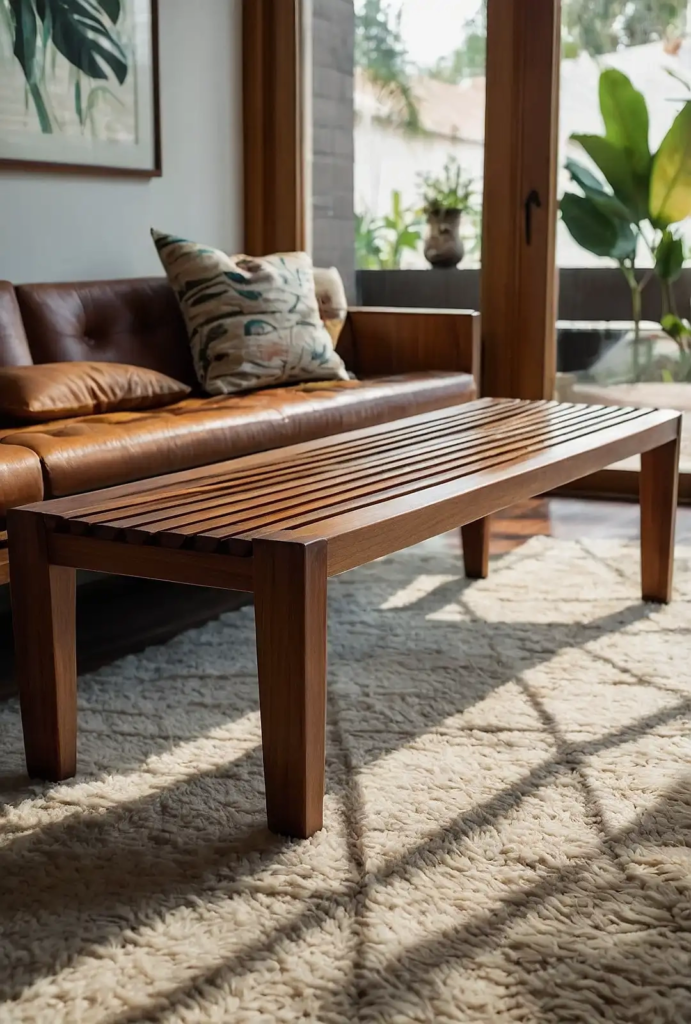
Incorporate a slatted wood bench as extra seating or as a coffee table alternative.
These versatile pieces showcase the era’s appreciation for natural materials and honest construction.
Position along a wall or floating in your space. The horizontal slats create linear rhythm that complements other midcentury pieces while providing functional seating.
18: Floor-to-Ceiling Windows

Maximize any large windows by arranging furniture to highlight these openings to the outdoors.
Midcentury architecture prioritized this indoor-outdoor connection. Keep window treatments minimal with simple panels that stack completely clear.
This emphasis on natural light and views embodies the midcentury modern philosophy.
19: Retro Color Blocking

Introduce strategic color blocks through furniture upholstery, pillows, or painted accent walls.
Look beyond neutrals to include mustard yellow, teal, rust orange, or avocado green.
Limit bold colors to a few key elements rather than overwhelming the space. This controlled approach to color creates visual interest while maintaining sophistication.
20: Floating Fireplace

Make a dramatic statement with a suspended or peninsula fireplace if you’re renovating.
These architectural showstoppers epitomize midcentury modern’s innovative approach to home design.
Choose white, black, or copper finishes for authentic midcentury appeal. This functional sculpture serves as both heating source and room divider in open floor plans.
21: Grass-cloth Wallcovering
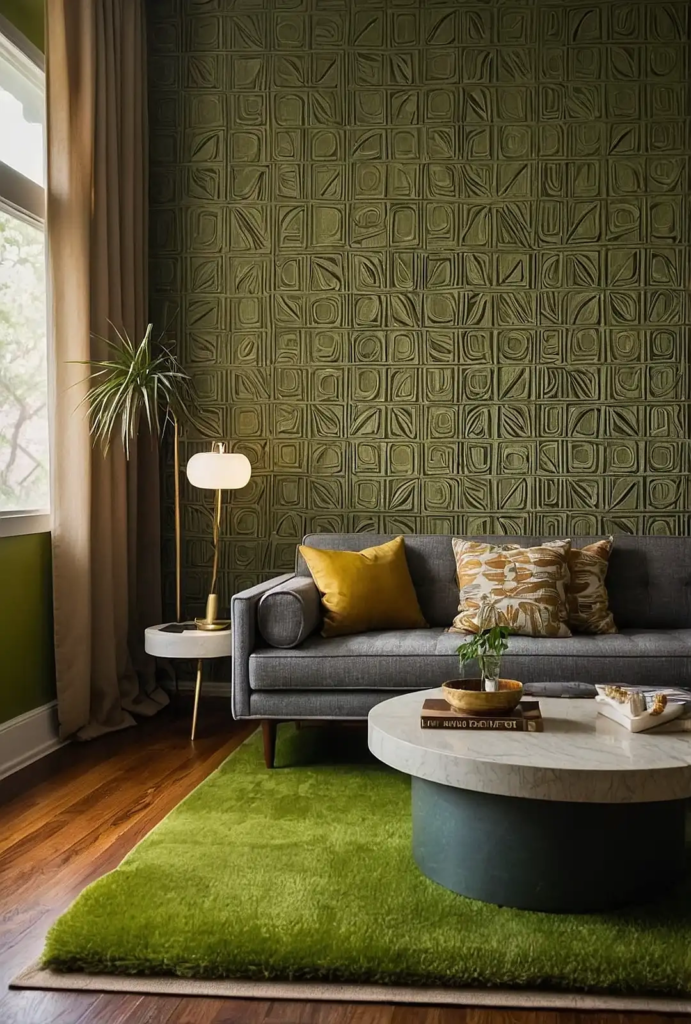
Apply textured grass-cloth wallpaper to create subtle organic pattern on an accent wall.
This natural material was highly popular during the midcentury period for its tactile quality.
Choose neutral tones for a sophisticated backdrop to your furniture. The woven texture adds warmth and dimension without competing with your decorative elements.
22: Low-Profile Modular Seating

Arrange modular, low-slung seating components that can be reconfigured for different social situations.
This versatility exemplifies midcentury design’s functional innovation. Choose pieces with removable bolsters and movable sections.
This adaptable approach to seating allows your living room to evolve based on your changing needs.
23: Floating Wood Credenza

Mount a wooden credenza to float several inches above the floor, creating the illusion of lightness despite the substantial storage piece.
This elevated installation feels both vintage and contemporary. Look for minimal hardware and clean lines.
The floating effect adds architectural interest while making your space appear larger and less cluttered.
24: Terrazzo Accents
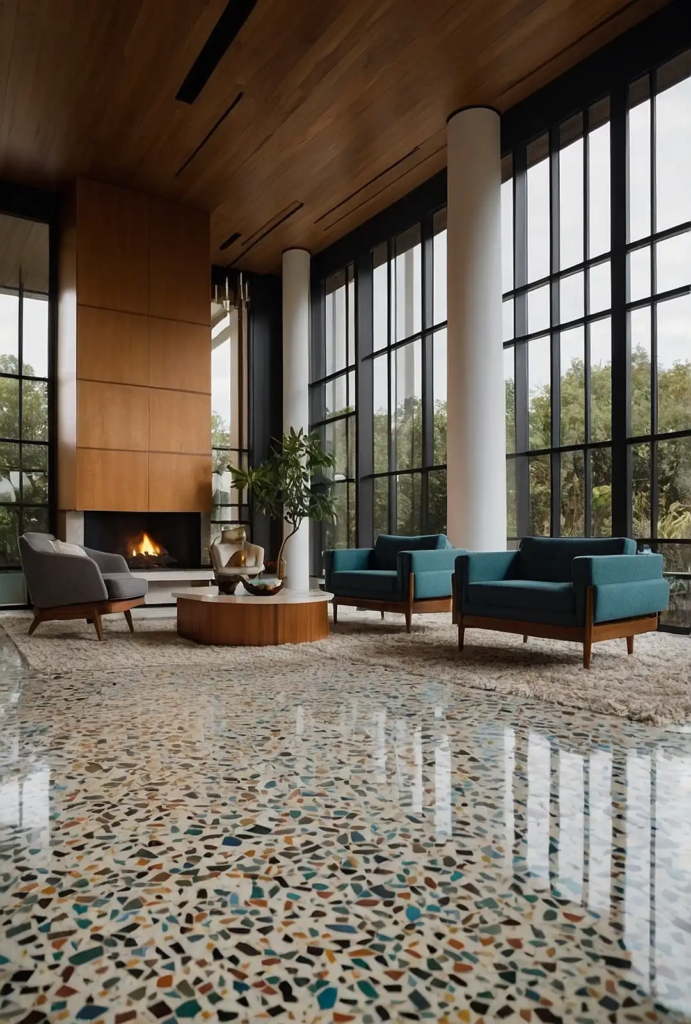
Incorporate terrazzo elements through side tables, planters, or decorative objects.
This composite material featuring colored chips in concrete gained popularity in midcentury architecture.
Choose pieces with a subtle color palette for sophistication. These speckled elements add textural interest while referencing authentic midcentury materials.
25: Globe Pendant Cluster

Hang a cluster of globe pendants at varying heights to create visual interest and effective ambient lighting. These simple spherical forms embody midcentury lighting design.
Choose opal glass for soft diffusion or clear glass for more dramatic light patterns.
The grouped arrangement creates an artistic installation that illuminates your space beautifully.
26: Curved Sectional Sofa

Balance straight lines with a curved sectional sofa that encourages conversation and adds organic flow to your space.
These sculptural seating pieces make a dramatic statement. Choose tufted upholstery for period authenticity.
The sweeping curve softens your room’s rectilinear elements while providing comfortable seating for larger gatherings.
27: Built-In Room Divider Storage

Create architectural interest with a partial-height built-in cabinet that divides space while providing display and storage opportunities.
These multifunctional elements were hallmarks of midcentury homes. Include open shelving on both sides for access from multiple areas.
This semi-permanent feature adds character while helping define different functional zones in open floor plans.
Conclusion
Midcentury modern design offers timeless appeal through its clean functionality, natural materials, and organic forms.
By incorporating these elements thoughtfully, you’ll create a living space that honors this iconic style while meeting contemporary needs.





